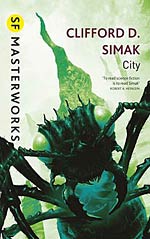
![]() SarahPi
SarahPi
5/29/2012
![]()
This slim white hardcover from the Science Fiction Book Club has caught my eye numerous times over the years, nestled between its bigger shelfmates in my family's science fiction collection. I had a vague knowledge that it was narrated by dogs, and a vague knowledge that this was a "fix-up novel" - a group of short stories tied together with an overarching structure for publication purposes. I'm glad I didn't go into it with any further preconceptions. Simak did an excellent job of linking the stories; I thought the conceit of the story notes added great depth to the ideas put forth in the stories.
The book consists of eight stories and a framework of notes that precede each story. I'd like to call them anthropological field notes, but I think the more accurate term might be caninological, since they are written by an advanced race of dogs. "These are the stories the Dogs tell, when the fires burn high and the wind is from the north," says one of the early notes. The stories the dogs examine span twelve thousand years, starting in a near future with dates now past. Some of the stories are put forth as apocryphal, some as fables, some as containing a germ of truth. They discusses the nature of time, and the nature of the bond between dogs and people, and the nature of dogs, and the instincts that govern both. A human family by the name of Webster is present in almost all of the tales. The Webster family robot, Jenkins, serves as the human proxy when no human is available, and as a common thread woven through the lengthy timeline. Jenkins is a surprisingly rich character, with fascinating motives.
I had never read Simak before, and didn't expect the beauty of the language or the depth of the ideas he explores. Though this is a story of dog, it is also a story of mutants and robots and ants and men and websters and Websters and cities and aliens and cobblies, all of which cycle in and out of the stories. I loved the way various members of that cast of characters appeared and reappeared. New situations were sketched with a deft hand, bringing the reader up to date quickly despite jumps of thousands of years.
If I have any complaint, it is the absolute lack of female characters. I don't think a single female dog is named in the entire book, and there are only a couple of human women, dismissed quickly. I can justify it somewhat by making a connection to fables and fireside stories, and suggesting that each Wolf and Bear and Squirrel is meant to stand for something larger. Still, it speaks to the quality of the stories and the concepts and the prose that I was mostly able to ignore the rather glaring omission of half of the population. I would probably name this as my new favorite novel-in-stories.